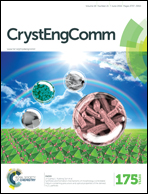Metal-driven assembly of peptidic foldamers: formation of molecular tapes†
Abstract
In this article, we report the use of a peptidic foldamer in the synthesis of supramolecular metal–organic structures. A peptidic ligand was designed and synthesised to adopt a canonical 310 helix with pyridyl ligands at each end, as confirmed by X-ray diffraction analysis. The combination of the synthesised peptide and silver salts under adequate reaction conditions results in the production of coordination polymers. The materials thus produced have been analysed by means of SEM-EDS, confirming the formation of long, regular, tape-shaped fibres that contain both the organic moiety and the metal atom. ATR FT-IR spectroscopy suggests that the helical structure of the peptide is preserved within the fibre.



 Please wait while we load your content...
Please wait while we load your content...